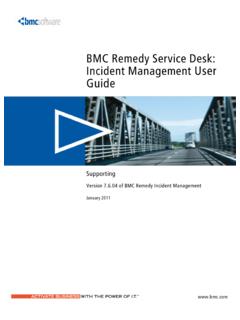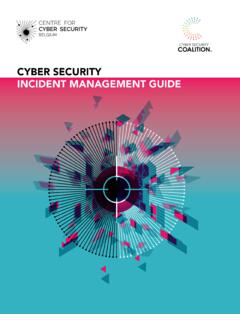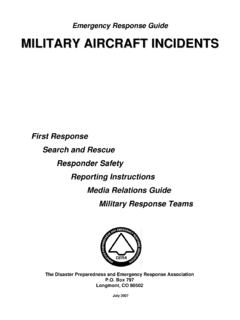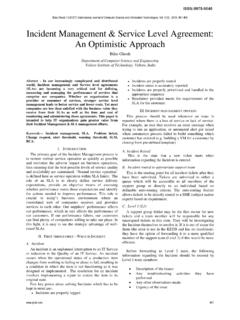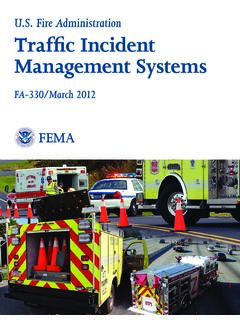Transcription of A Framework for Incident and Problem Management
1 Incident and Problem Management Framework April 2003 INS Whitepaper 1 A Framework for Incident and Problem Management By Victor Kapella Consulting Manager International Network Services The knowledgebehind the network. A Framework for Incident and Problem Management By Victor Kapella, Consulting Manager Introduction Many organizations have developed multi-tiered, information technology (IT) support services delivered by help desks , network operations centers (NOCs) and engineering organizations. A common mistake made when developing these services is to focus on responding to incidents instead of on preventing problems from occurring in the first place. The relationship among these service activities is not well understood, thus many organizations fail to successfully execute proactive Problem prevention. This whitepaper defines Incident and Problem Management based on the Information Technology Infrastructure Library (ITIL) Service Support best practices and INS s experience in the industry.
2 It further explains the differences between Incident Management and Problem Management and offers a Framework for addressing both activities. The Language of Incident , Problems and Errors The ITIL Service Support is an internationally recognized best practices model used to guide IT organizations in developing their service Management approaches. This model has been widely adopted. It is prescriptive in nature and identifies elements, in addition to Incident and Problem Management , that need to be addressed to successfully run an IT organization like a service business. This model defines a technical vocabulary for the discussion of support services. It defines clear concepts and draws distinctions between various support activities. For example, the activities required to respond to service interruptions and to restore service have different qualities than those activities required to identify and permanently remove the underlying cause of service interruptions.
3 Incidents An Incident is any event that is not part of the standard operation of a service and causes, or may cause, an interruption to or reduction in the quality of that service. Examples of incidents are: ` User cannot receive e-mail ` NOC monitoring tool indicates that a WAN circuit may be down ` User perceives that an application is running slow Problems A Problem is an unknown, underlying cause of one or more incidents. A single Problem may generate several incidents. Incident and Problem Management Framework April 2003 INS Whitepaper 2 Errors An error is a Problem for which the root cause has been identified and a workaround or permanent solution has been developed. Errors can be identified through analysis of user complaints or by vendors and development staff prior to production implementation. Examples of errors include: ` Laptop network settings misconfigured ` Monitoring tool misidentifies WAN circuit status when polled router is busy Managing Incidents and Problems The key concepts and language of Incident and Problem Management are shown in Figure 1.
4 There is a lifecycle relationship among incidents, problems and errors: incidents are often the indicators of problems; problems lead to the identification of the root cause of the underlying error; errors are then systematically eliminated. Figure 1: IM and PM Concepts IncidentsProblemsErrorsIncidentsProblems Errors Problem control find root cause Error control fix Problem Incident Management Incident detection and recording Classification and initial support Investigation and diagnosis Resolution and recovery Closure Ownership, monitoring, tracking and communicationProactive PM Analyze Incident trends over time Liaise with development organizations Develop and implement permanent fixesTool GeneratedTool GeneratedHelp Desk CallsHelp Desk CallsProblem ManagementIncident and Problem Management Framework April 2003 INS Whitepaper 3 Incident Management Incident Management (IM) refers to activities undertaken to restore normal service operation as quickly as possible while minimizing adverse impact on business operations.
5 IM is a reactive, short-term focus on restoring service. IM activities include: ` Incident detection and recording ` Classification and initial support ` Investigation and diagnosis ` Resolution and recovery ` Closure Problem Management Problem Management (PM) refers to activities undertaken to minimize the adverse impact on the business of problems that are caused by errors within the IT infrastructure, and to prevent recurrence of incidents related to these errors. PM gets to the root cause of problems, identifies workarounds or permanent fixes and eliminates errors. PM activities include: ` Problem control ` Error control ` Proactive Problem prevention ` Major Problem reviews Problem Control The purpose of Problem control is to find the root cause of a Problem by executing the following steps: ` Identifying and recording of the Problem ` Classifying the Problem and prioritizing response activities ` Investigating and diagnosing root causes Error Control Error control activities ensure that problems are fixed by executing the following steps: ` Identifying and recording known errors ` Assessing permanent fixes and prioritization ` Resolution recording of temporary workarounds into service support tools ` Closure of known errors by implementing permanent fixes ` Monitoring known errors to determine if a change in priority is warranted Problem Review The purpose of a Problem review is to improve IM and PM processes.
6 This is accomplished by performing a post-mortem examination of the quality of the IM and PM response activities associated with a major Incident or Problem . Incident and Problem Management Framework April 2003 INS Whitepaper 4 Organizational Roles and Responsibilities The most common support structure that INS encounters is a tiered model where increasing levels of technical capability are applied to the resolution of an Incident or Problem . A typical organizational structure for this tiered support model is shown in Figure 2. Figure 2: Typical Tiered Support Model The actual roles and responsibilities seen in tiered support implementations are as varied as the people, history and politics that comprise an organization s environment. The following description of a tiered support model is typical in many organizations. Level 1 Support The organization providing level 1 support commonly resides in the Operations group and is typically identified as a Call Center, Help Desk, Service Desk or other similar name.
7 Roles Owner of the IM process. Level 1 support ensures that a well defined, consistently executed, properly measured and effective IM process is established and maintained. Receive and manage all customer service issues. Level 1 support is the single point of contact for reporting service issues, and acts as end-user advocate to ensure that service issues are resolved in a timely fashion. First line of support. The level 1 organization makes the first attempt to resolve the service issue reported by the end user. Responsibilities Accurately record incidents. Level 1 support ensures that an Incident is properly logged into the Incident Management system. In doing so, it must: ` Ensure that the ticket contains an accurate and properly detailed description of the Problem ` Ensure that the severity/priority classification is correct ` Determine the nature of the Problem , business partner contacts, impacts and expectations Incident and Problem Management Framework April 2003 INS Whitepaper 5 Own every Incident .
8 As the end-user advocate, level 1 support owns the successful resolution of every Incident . It ensures that the IM process resolves the issue in a timely fashion by: ` Developing and managing a resolution action plan ` Initiating specific assignments for staff and business partners ` Escalating the Incident as required when resolution targets are missed ` Ensuring internal communication occurs according to defined service targets ` Championing the interests of the involved business partners Level 1 support uses the Problem Management database to match incidents with known errors and to apply previously identified workarounds to resolve incidents. Its target is to resolve 80 percent of incidents. The remaining incidents are escalated to level 2 Continually improve the IM process. As owner of the IM process, level 1 support ensures that the process and capabilities are adequate, and are improved when necessary by: Evaluating the effectiveness of the IM process and supporting mechanisms such as reports, communication formats/messages, and escalation procedures ` Developing department-specific reports and procedures ` Maintaining and improving communication and escalation lists ` Participating in the Problem review process Capabilities Interpersonal skills paramount; technical skills secondary.
9 Level 1 support personnel are primarily involved in triage and Management of problems. Very little technical troubleshooting should occur at this level of support. Ability to apply canned resolutions. Level 1 personnel should have the ability to recognize patterns of symptoms, apply search tools to identify previously developed solutions, and help end-users implement the solution. Level 2 Support Also typically residing in the Operations group, level 2 support organizations are commonly called Command Centers, Network Operations Centers, or Distributed Computing Control Centers. Roles Troubleshoot incidents. Level 2 support investigates, diagnoses and resolves most incidents that are not cleared by level 1 support. These incidents tend to be indicative of new problems. Owner of PM process. Level 2 support ensures that a well-defined and effective Problem Management process, as previously defined, is in place. Proactive Management of the infrastructure.
10 Level 2 support uses tools and processes to ensure that problems are identified and resolved before incidents occur. Responsibilities Resolve incidents escalated from level 1. Whereas level 1 is expected to resolve 80 percent of incidents, level 2 support is expected to resolve 75 percent of incidents that are escalated to them, for an overall total of 15 percent of the incidents reported to level 1 support. The unresolved incidents are escalated to level 3 support Incident and Problem Management Framework April 2003 INS Whitepaper 6 Determine root cause of problems. Level 2 support determines the root cause of problems and identifies workarounds or permanent fixes. They engage and manage other resources as necessary to determine the root cause. They escalate Problem resolution to level 3 support when the root cause is an architectural or technical issue that exceeds their skill-set. Champions the implementation of workarounds and permanent fixes.

